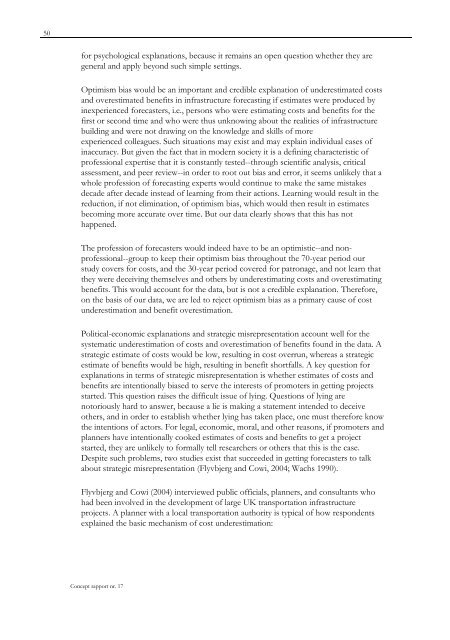How Optimism Bias and Strategic ... - Concept - NTNU
How Optimism Bias and Strategic ... - Concept - NTNU
How Optimism Bias and Strategic ... - Concept - NTNU
Create successful ePaper yourself
Turn your PDF publications into a flip-book with our unique Google optimized e-Paper software.
50<br />
for psychological explanations, because it remains an open question whether they are<br />
general <strong>and</strong> apply beyond such simple settings.<br />
<strong>Optimism</strong> bias would be an important <strong>and</strong> credible explanation of underestimated costs<br />
<strong>and</strong> overestimated benefits in infrastructure forecasting if estimates were produced by<br />
inexperienced forecasters, i.e., persons who were estimating costs <strong>and</strong> benefits for the<br />
first or second time <strong>and</strong> who were thus unknowing about the realities of infrastructure<br />
building <strong>and</strong> were not drawing on the knowledge <strong>and</strong> skills of more<br />
experienced colleagues. Such situations may exist <strong>and</strong> may explain individual cases of<br />
inaccuracy. But given the fact that in modern society it is a defining characteristic of<br />
professional expertise that it is constantly tested--through scientific analysis, critical<br />
assessment, <strong>and</strong> peer review--in order to root out bias <strong>and</strong> error, it seems unlikely that a<br />
whole profession of forecasting experts would continue to make the same mistakes<br />
decade after decade instead of learning from their actions. Learning would result in the<br />
reduction, if not elimination, of optimism bias, which would then result in estimates<br />
becoming more accurate over time. But our data clearly shows that this has not<br />
happened.<br />
The profession of forecasters would indeed have to be an optimistic--<strong>and</strong> nonprofessional--group<br />
to keep their optimism bias throughout the 70-year period our<br />
study covers for costs, <strong>and</strong> the 30-year period covered for patronage, <strong>and</strong> not learn that<br />
they were deceiving themselves <strong>and</strong> others by underestimating costs <strong>and</strong> overestimating<br />
benefits. This would account for the data, but is not a credible explanation. Therefore,<br />
on the basis of our data, we are led to reject optimism bias as a primary cause of cost<br />
underestimation <strong>and</strong> benefit overestimation.<br />
Political-economic explanations <strong>and</strong> strategic misrepresentation account well for the<br />
systematic underestimation of costs <strong>and</strong> overestimation of benefits found in the data. A<br />
strategic estimate of costs would be low, resulting in cost overrun, whereas a strategic<br />
estimate of benefits would be high, resulting in benefit shortfalls. A key question for<br />
explanations in terms of strategic misrepresentation is whether estimates of costs <strong>and</strong><br />
benefits are intentionally biased to serve the interests of promoters in getting projects<br />
started. This question raises the difficult issue of lying. Questions of lying are<br />
notoriously hard to answer, because a lie is making a statement intended to deceive<br />
others, <strong>and</strong> in order to establish whether lying has taken place, one must therefore know<br />
the intentions of actors. For legal, economic, moral, <strong>and</strong> other reasons, if promoters <strong>and</strong><br />
planners have intentionally cooked estimates of costs <strong>and</strong> benefits to get a project<br />
started, they are unlikely to formally tell researchers or others that this is the case.<br />
Despite such problems, two studies exist that succeeded in getting forecasters to talk<br />
about strategic misrepresentation (Flyvbjerg <strong>and</strong> Cowi, 2004; Wachs 1990).<br />
Flyvbjerg <strong>and</strong> Cowi (2004) interviewed public officials, planners, <strong>and</strong> consultants who<br />
had been involved in the development of large UK transportation infrastructure<br />
projects. A planner with a local transportation authority is typical of how respondents<br />
explained the basic mechanism of cost underestimation:<br />
<strong>Concept</strong> rapport nr. 17

















